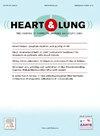Non-invasive monitoring strategies for atrial fibrillation detection in adult cardiac surgery patients after hospital discharge: A scoping review
IF 2.6
4区 医学
Q2 CARDIAC & CARDIOVASCULAR SYSTEMS
引用次数: 0
Abstract
Background
Atrial fibrillation (AF) is a common complication after cardiothoracic surgery, affecting up to 50 % of patients. It can develop after discharge, leading to frequent hospital readmissions. There is a growing need for effective monitoring strategies to detect AF in the post-discharge period.
Objectives
To synthesis the available literature on various mobile monitoring devices used to detect AF in adult cardiac surgery patients post-discharge from the hospital.
Methods
Following Arksey and O’Malley’s framework and the PRISMA-ScR guidelines. A comprehensive search of six databases (PubMed; MEDLINE; CINAHL; Scopus; ProQuest; and Web of Science) was performed, including studies published between 2009 and 2024. The risk of bias was assessed using the Newcastle-Ottawa Scale (NOS).
Results
A total of 1256 de-duplicated studies were screened, and 102 studies underwent full-text review. Five studies were included: four prospective cohort studies, and one randomised clinical trial. Samples sizes ranged from 23 to 730 adults undergoing cardiac surgery, with follow-up between four weeks to three months post-discharge. Handheld and wearable ECG-based devices were the most used tools for AF detection, demonstrating high sensitivity and specificity. Their use effectively reduced unplanned hospital visits and improved clinical outcomes. Patient adherence to monitoring protocols was generally high, though variability in engagement was noted.
Conclusions
Handheld and wearable ECG- based devices, are effective for post-discharge AF detection in cardiac surgery patients. Integrating these tools into routine post-discharge care can improve patient outcomes. Future research should focus on long-term effectiveness and strategies to optimise patient engagement and implementation in clinical practice.
成人心脏手术患者出院后房颤检测的无创监测策略:范围综述
背景:房颤(AF)是心胸外科手术后常见的并发症,影响高达50%的患者。它可以在出院后发展,导致频繁的再入院。越来越需要有效的监测策略来检测房颤在出院后的时期。目的综合各种移动监测设备用于检测成人心脏手术患者出院后房颤的现有文献。方法遵循Arksey和O 'Malley的框架和PRISMA-ScR指南。对六个数据库(PubMed;MEDLINE;CINAHL;斯高帕斯;它;和Web of Science),包括2009年至2024年间发表的研究。偏倚风险采用纽卡斯尔-渥太华量表(NOS)进行评估。结果共筛选1256项去重复研究,102项研究进行了全文综述。纳入了5项研究:4项前瞻性队列研究和1项随机临床试验。样本大小从23到730名接受心脏手术的成年人不等,随访时间为出院后4周到3个月。手持式和可穿戴式ecg设备是AF检测最常用的工具,具有高灵敏度和特异性。它们的使用有效地减少了计划外的医院就诊并改善了临床结果。患者对监测方案的依从性普遍较高,尽管注意到参与的可变性。结论手持式和可穿戴式心电仪是心脏手术患者出院后房颤检测的有效手段。将这些工具整合到常规出院后护理中可以改善患者的预后。未来的研究应侧重于长期有效性和策略,以优化临床实践中的患者参与和实施。
本文章由计算机程序翻译,如有差异,请以英文原文为准。
求助全文
约1分钟内获得全文
求助全文
来源期刊

Heart & Lung
医学-呼吸系统
CiteScore
4.60
自引率
3.60%
发文量
184
审稿时长
35 days
期刊介绍:
Heart & Lung: The Journal of Cardiopulmonary and Acute Care, the official publication of The American Association of Heart Failure Nurses, presents original, peer-reviewed articles on techniques, advances, investigations, and observations related to the care of patients with acute and critical illness and patients with chronic cardiac or pulmonary disorders.
The Journal''s acute care articles focus on the care of hospitalized patients, including those in the critical and acute care settings. Because most patients who are hospitalized in acute and critical care settings have chronic conditions, we are also interested in the chronically critically ill, the care of patients with chronic cardiopulmonary disorders, their rehabilitation, and disease prevention. The Journal''s heart failure articles focus on all aspects of the care of patients with this condition. Manuscripts that are relevant to populations across the human lifespan are welcome.
 求助内容:
求助内容: 应助结果提醒方式:
应助结果提醒方式:


